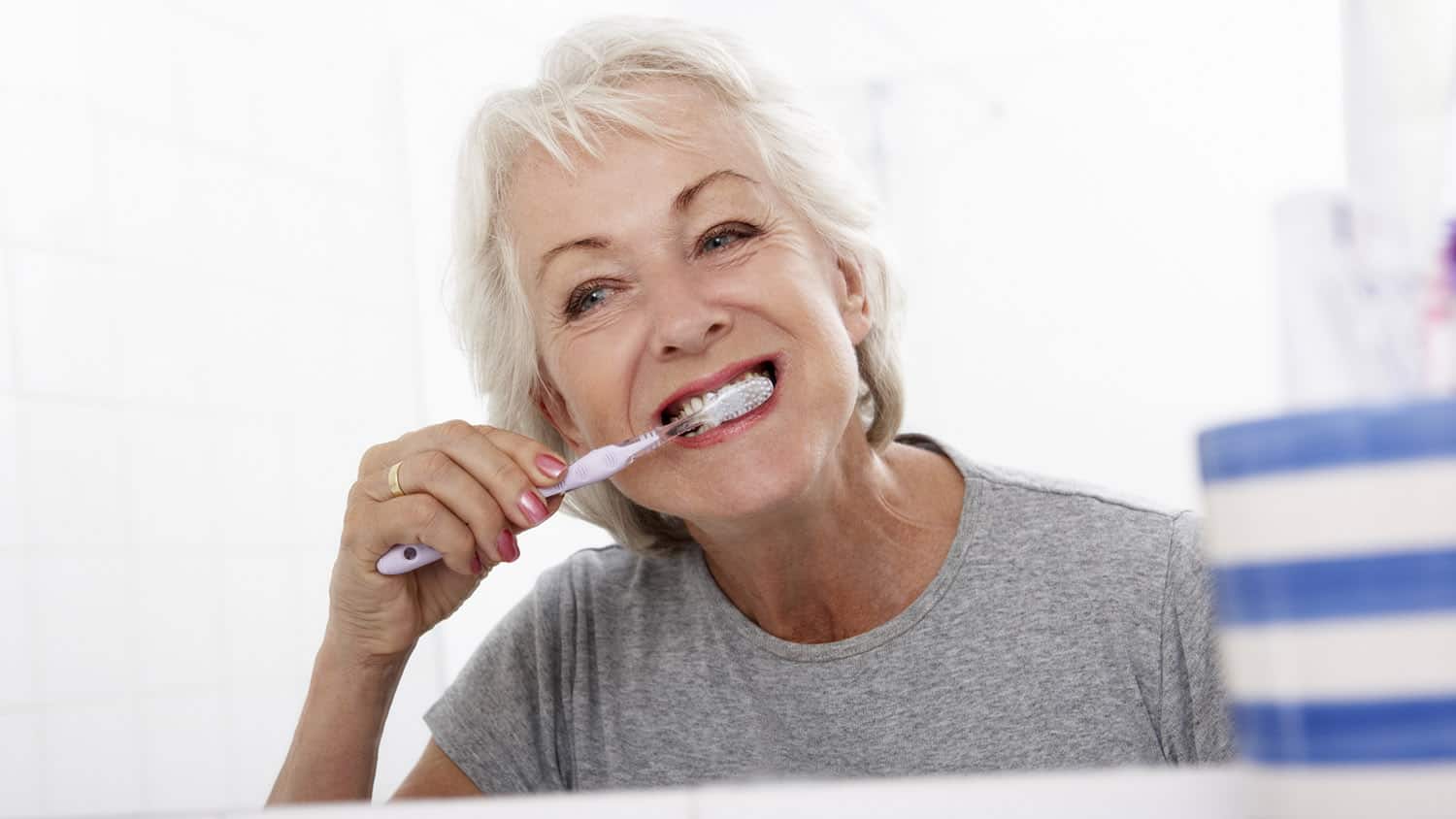
Over 50? Maybe it’s Time to Upgrade Your Tooth Brushing Technique!
You’ve done it every day of your life, but when is the last time you thought about your tooth brushing routine?
Are you still following the brushing instructions you were given for cleaning a youthful mouth some 30 or even 60 years ago?
Do you know what kind of brushing older teeth need, especially for mouths with fillings, crowns, gaps or implants? Certain medications, poor nutrition, too much stress or tension in the jaw can make teeth enamel or gum lines soft and vulnerable to being damaged by inappropriate brushing techniques.
Better brushing can help to maintain your teeth and gums in perfect health for the rest of your life.
Find out if you are using the best brush for your needs, perfect your brushing technique and tweak your timing to give your teeth and gums the best possible chance to prevent tooth decay and gum disease.
When it Comes to Your Tooth Brushing Technique, Softer is Better
Always choose the softest bristles for your toothbrush to avoid scratching or gouging the surface of your teeth with a firm toothbrush. Firm and even medium bristles wear down soft enamel, making it more vulnerable to decay. A soft brush allows you to gently polish the surface of your teeth, leaving them so glassy that plaque can’t stick to them.
Rubbing your gums with hard bristles can break the delicate surface membranes, allowing bacteria from your mouth to enter your bloodstream and potentially lead to inflammation in your gut, heart or lungs.
Hard bristles on an electric toothbrush can be even more damaging than those on a regular manual brush. Speedy electric toothbrushes increase the impact of your tooth brushing technique, so it’s even more important to use a soft bristled head and hold lightly against your teeth than with a manual toothbrush.
You can soften your toothbrush even more by running it under hot water before you start brushing.
Polish, Don’t Scrub
Instead of scrubbing your teeth like you are cleaning a kitchen floor, imagine you are gently polishing antique silver plate. Ideally, you can brush so lightly that even after six months your toothbrush bristles will still look brand new!
Try to hold your toothbrush with the tips of your fingers very close to the toothbrush head – like a fancy lady sipping from her bone china teacup. With your fine-motor skills in play it is much easier to brush gently than if you are gripping the end of the brush in your fist. If it is difficult for you to hold a manual brush this way, try an electric toothbrush, which you can grip while applying the lightest touch possible to your teeth.
When you are brushing your teeth, be sure to avoid brushing into the gum line. Brushing carelessly into your gums contributes to receding gums, gum pockets or abrasions that can lead to gum disease. If you have receding or bleeding gums you really need to use soft, round-tipped bristles and brush very, very gently.
You can brush your gums, but this should be done separately with a dry, soft-bristled manual toothbrush. You can buy gum brushes or use a baby toothbrush, which is small and soft. Always brush gums from the jaw towards the teeth, so with a downward motion on the top gums and upward on the bottom gums.
Brush Early
Plaque begins to rebuild within six hours of brushing, so it is important to brush both morning and night. However, you should always wait for an hour after you eat before brushing, because your enamel is at its softest and most vulnerable then from acids and sugars.
The best time to brush in the morning is as soon as you get up, to give your mouth a fresh start for the day. Then, when you start to eat and drink there is less harmful bacteria interacting with the breakfast food in your mouth.
In the evening, wait an hour or so after you’ve finished eating, but don’t wait until you are too tired to brush carefully. Brushing an hour or two before you are ready for bed allows you to brush with your full attention.
Slow Down, You Brush Too Fast
The most important tooth brushing tip I tell my holistic teeth health clients is to brush slowly. You should brush each tooth surface individually, stroking away from the gum. Ideally, you will be your brushing teeth for 2-3 minutes in each session. If you are used to rushing through brushing then it may feel very unnatural and boring to slow down.
One way to help yourself stay on task is to distract yourself. Watch TV, listen to music, the radio, a talking book or a podcast as you brush.
Try sharing tooth brushing time with a grandchild, either in person or on Skype. You will be a role model of good self-care and benefit from their fresh approach as a beginner brusher. Set a timer for three minutes and see who can brush the longest!
Another, even more effective technique is to treat tooth brushing as a twice daily mindfulness practice. As you brush you can look in the mirror and think positive affirmations. Your teeth cleaning time is the best time to think loving thoughts towards your teeth and gums, and forgive yourself any imperfections.
Your teeth have been with you for a long time. You can keep them forever by adapting your routine to show them the love and care they need as they grow older with you.
Do you feel like you take good care of your teeth? Do you use a soft or medium tooth brush? Do you spend between two and three minutes brushing your teeth? How are you taking care of your teeth in your 60s? Please share in the comments.
Tags Medical Conditions






